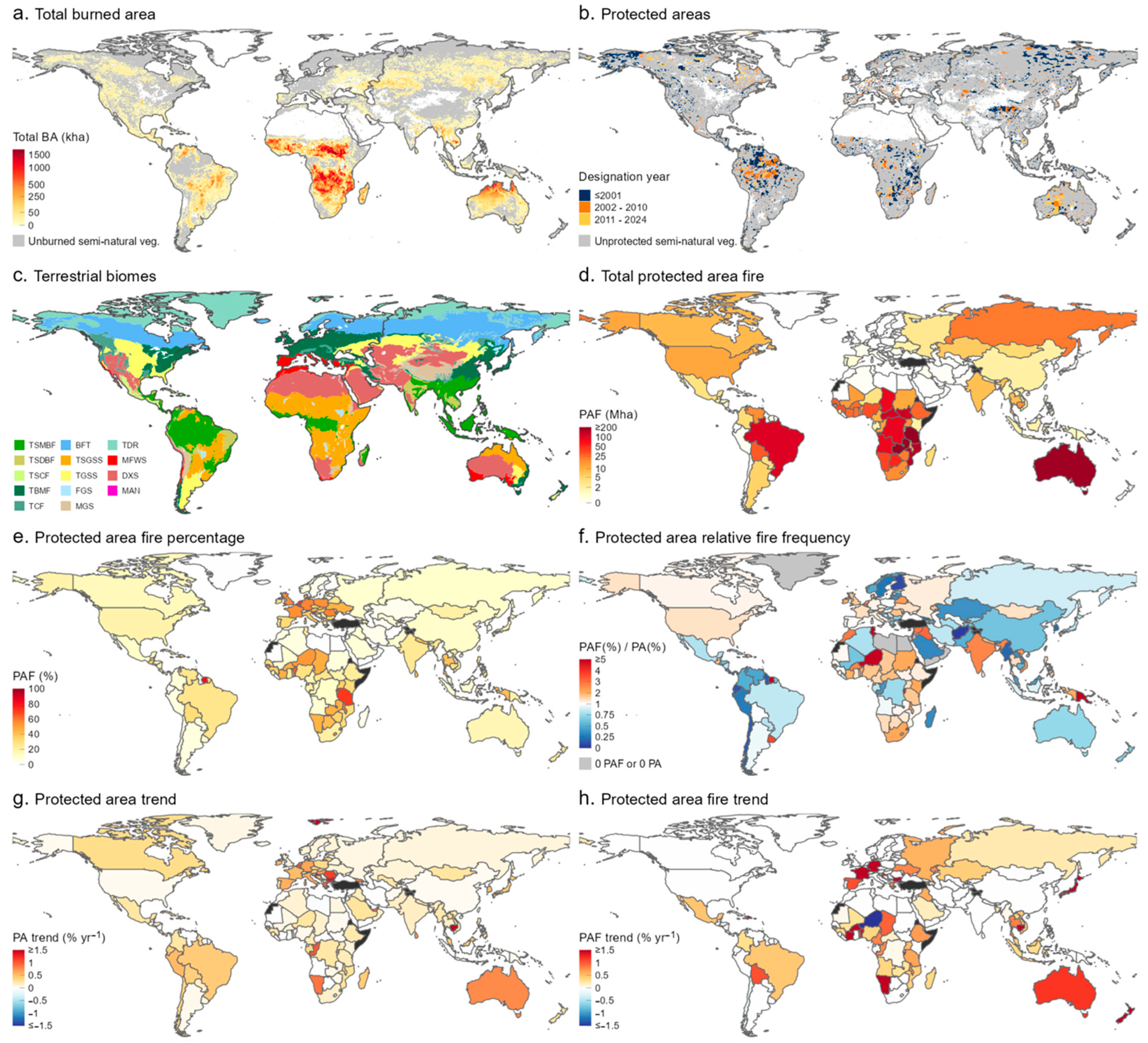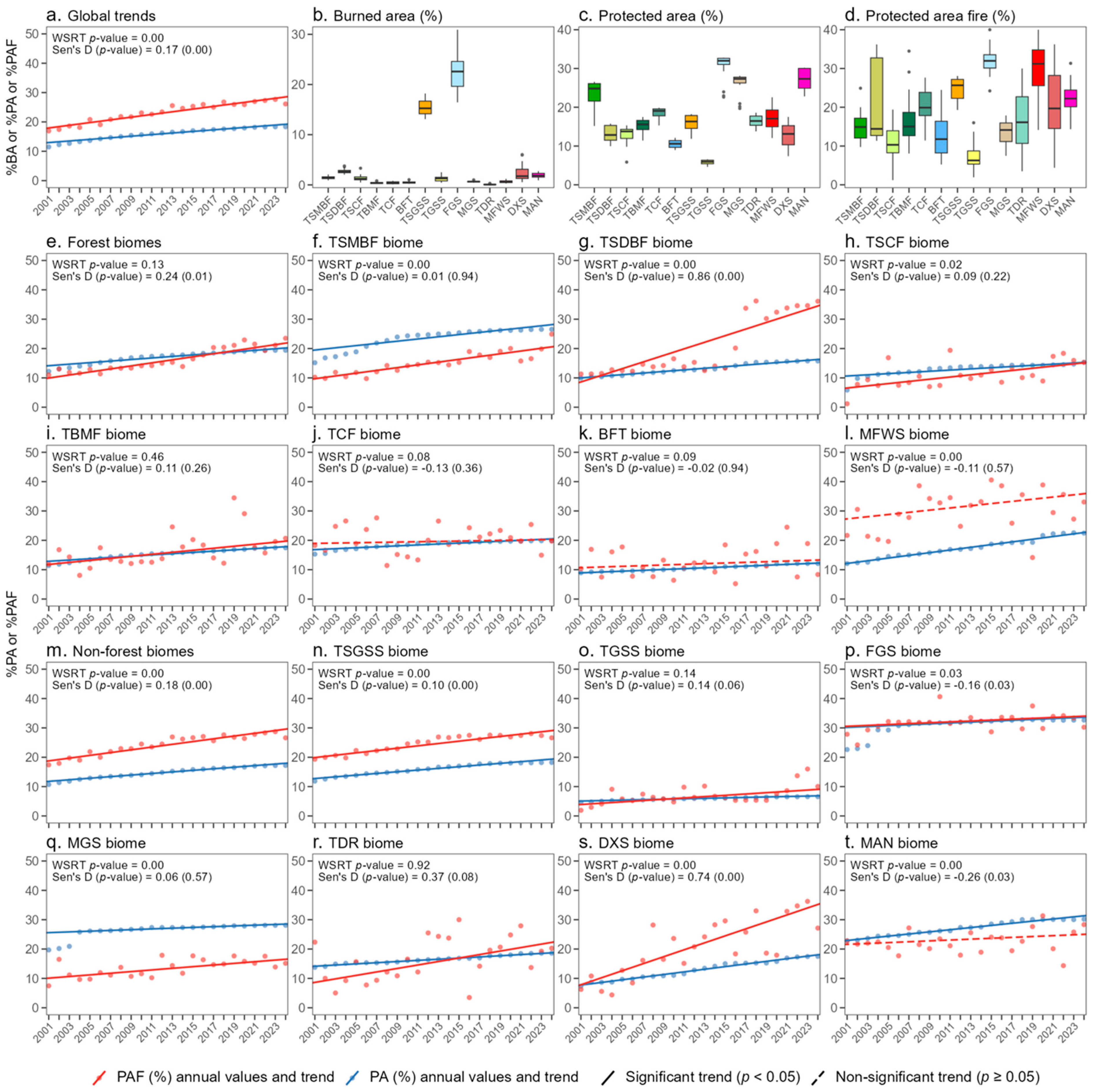Protected Areas Show Substantial and Increasing Risk of Wildfire Globally
Abstract
1. Introduction
2. Materials and Methods
2.1. Global Maps of Protected Areas
2.2. Burned Area and Land Cover Maps
2.3. Statistical Analyses
3. Results
4. Discussion
Author Contributions
Funding
Data Availability Statement
Conflicts of Interest
References
- Homer-Dixon, T.; Renn, O.; Rockstrom, J.; Donges, J.F.; Janzwood, S. A Call for An International Research Program on the Risk of a Global Polycrisis. SSRN J. 2021. [Google Scholar] [CrossRef]
- IPBES. Summary for Policymakers of the Global Assessment Report on Biodiversity and Ecosystem Services of the Intergovernmental Science-Policy Platform on Biodiversity and Ecosystem Services; IPBES Secretariat: Bonn, Germany, 2019. [Google Scholar]
- Fernández-García, V.; Alonso-González, E. Global Patterns and Dynamics of Burned Area and Burn Severity. Remote Sens. 2023, 15, 3401. [Google Scholar] [CrossRef]
- Langhammer, P.F.; Bull, J.W.; Bicknell, J.E.; Oakley, J.L.; Brown, M.H.; Bruford, M.W.; Butchart, S.H.M.; Carr, J.A.; Church, D.; Cooney, R.; et al. The Positive Impact of Conservation Action. Science 2024, 384, 453–458. [Google Scholar] [CrossRef]
- Doherty, T.S.; Macdonald, K.J.; Nimmo, D.G.; Santos, J.L.; Geary, W.L. Shifting Fire Regimes Cause Continent-Wide Transformation of Threatened Species Habitat. Proc. Natl. Acad. Sci. USA 2024, 121, e2316417121. [Google Scholar] [CrossRef]
- Nelson, A.; Chomitz, K.M. Effectiveness of Strict vs. Multiple Use Protected Areas in Reducing Tropical Forest Fires: A Global Analysis Using Matching Methods. PLoS ONE 2011, 6, e22722. [Google Scholar] [CrossRef]
- Rodrigues, M.; Cunill Camprubí, À.; Balaguer-Romano, R.; Coco Megía, C.J.; Castañares, F.; Ruffault, J.; Fernandes, P.M.; Resco de Dios, V. Drivers and Implications of the Extreme 2022 Wildfire Season in Southwest Europe. Sci. Total Environ. 2023, 859, 160320. [Google Scholar] [CrossRef]
- UNEP-WCMC. IUCNProtected Planet: The World Database on Protected Areas (WDPA), World Database on Other Effective Area-Based Conservation Measures (WD-OECM). UNEP-WCMC, IUCN: Cambridge, UK, January 2025. Available online: www.protectedplanet.net (accessed on 1 February 2025).
- Dinerstein, E.; Olson, D.; Joshi, A.; Vynne, C.; Burgess, N.D.; Wikramanayake, E.; Hahn, N.; Palminteri, S.; Hedao, P.; Noss, R.; et al. An Ecoregion-Based Approach to Protecting Half the Terrestrial Realm. Bioscience 2017, 67, 534–545. [Google Scholar] [CrossRef]
- Jones, K.R.; Venter, O.; Fuller, R.A.; Allan, J.R.; Maxwell, S.L.; Negret, P.J.; Watson, J.E.M. One-Third of Global Protected Land Is under Intense Human Pressure. Science 2018, 360, 788–791. [Google Scholar] [CrossRef] [PubMed]
- Maxwell, S.L.; Cazalis, V.; Dudley, N.; Hoffmann, M.; Rodrigues, A.S.L.; Stolton, S.; Visconti, P.; Woodley, S.; Kingston, N.; Lewis, E.; et al. Area-Based Conservation in the Twenty-First Century. Nature 2020, 586, 217–227. [Google Scholar] [CrossRef] [PubMed]
- Butchart, S.H.M.; Clarke, M.; Smith, R.J.; Sykes, R.E.; Scharlemann, J.P.W.; Harfoot, M.; Buchanan, G.M.; Angulo, A.; Balmford, A.; Bertzky, B.; et al. Shortfalls and Solutions for Meeting National and Global Conservation Area Targets. Conserv. Lett. 2015, 8, 329–337. [Google Scholar] [CrossRef]
- Li, B.V.; Pimm, S.L. How China Expanded Its Protected Areas to Conserve Biodiversity. Curr. Biol. 2020, 30, R1334–R1340. [Google Scholar] [CrossRef]
- Giglio, L.; Justice, C.; Boschetti, L.; Roy, D. MODIS/Terra+Aqua Burned Area Monthly L3 Global 500m SIN Grid V061. Distributed by NASA EOSDIS Land Processes Distributed Active Archive Center. 2021. Available online: https://doi.org/10.5067/MODIS/MCD64A1.061 (accessed on 1 June 2024).
- Friedl, M.; Sulla-Menashe, D. MODIS/Terra+Aqua Land Cover Type Yearly L3 Global 500m SIN Grid V061. NASA EOSDIS Land Processes Distributed Active Archive Center. Available online: https://www.earthdata.nasa.gov/data/catalog/lpcloud-mcd12q1-061 (accessed on 1 June 2024).
- Dobrowski, S.Z.; Littlefield, C.E.; Lyons, D.S.; Hollenberg, C.; Carroll, C.; Parks, S.A.; Abatzoglou, J.T.; Hegewisch, K.; Gage, J. Protected-Area Targets Could Be Undermined by Climate Change-Driven Shifts in Ecoregions and Biomes. Commun. Earth Environ. 2021, 2, 198. [Google Scholar] [CrossRef]
- Bousfield, C.G.; Lindenmayer, D.B.; Edwards, D.P. Substantial and Increasing Global Losses of Timber-Producing Forest Due to Wildfires. Nat. Geosci. 2023, 16, 1145–1150. [Google Scholar] [CrossRef]
- Mann, H.B. Nonparametric Tests Against Trend. Econometrica 1945, 13, 245–259. [Google Scholar] [CrossRef]
- Kendall, M.G. Further Contributions to the Theory of Paired Comparisons. Biometrics 1955, 11, 43–62. [Google Scholar] [CrossRef]
- Pebesma, E. Simple Features for R: Standardized Support for Spatial Vector Data. R J. 2018, 10, 439–446. [Google Scholar] [CrossRef]
- Pebesma, E. Lwgeom: Bindings to Selected Liblwgeom Functions for Simple Features. 2024. Available online: https://r-spatial.github.io/lwgeom/ (accessed on 1 June 2024).
- Teucher, A.; Russell, K. Rmapshaper: Client for Mapshaper for Geospatial Operations. 2023. Available online: https://github.com/ateucher/rmapshaper (accessed on 1 June 2024).
- Corporation, M.; Weston, S. doParallel: Foreach Parallel Adaptor for the Parallel Package. 2022. Available online: https://github.com/revolutionanalytics/doparallel (accessed on 1 June 2024).
- Microsoft; Weston, S. Foreach: Provides Foreach Looping Construct. 2022. Available online: https://github.com/revolutionanalytics/foreach (accessed on 1 June 2024).
- Pohlert, T. Trend: Non-Parametric Trend Tests and Change-Point Detection. 2023. Available online: https://CRAN.R-project.org/package=trend (accessed on 1 June 2024).
- Zubkova, M.; Humber, M.L.; Giglio, L. Is Global Burned Area Declining Due to Cropland Expansion? How Much Do We Know Based on Remotely Sensed Data? Int. J. Remote Sens. 2023, 44, 1132–1150. [Google Scholar] [CrossRef]
- Boer, M.M.; Resco De Dios, V.; Stefaniak, E.Z.; Bradstock, R.A. A Hydroclimatic Model for the Distribution of Fire on Earth. Environ. Res. Commun. 2021, 3, 035001. [Google Scholar] [CrossRef]
- Cui, X.; Paterson, A.M.; Wyse, S.V.; Alam, M.A.; Maurin, K.J.L.; Pieper, R.; Padulles Cubino, J.; O’Connell, D.M.; Donkers, D.; Breda, J.; et al. Shoot Flammability of Vascular Plants Is Phylogenetically Conserved and Related to Habitat Fire-Proneness and Growth Form. Nat. Plants 2020, 6, 355–359. [Google Scholar] [CrossRef] [PubMed]
- Minnich, R.A. Fire Mosaics in Southern California and Northern Baja California. Science 1983, 219, 1287–1294. [Google Scholar] [CrossRef]
- Mariani, M.; Wills, A.; Herbert, A.; Adeleye, M.; Florin, S.A.; Cadd, H.; Connor, S.; Kershaw, P.; Theuerkauf, M.; Stevenson, J.; et al. Shrub Cover Declined as Indigenous Populations Expanded across Southeast Australia. Science 2024, 386, 567–573. [Google Scholar] [CrossRef]
- Moritz, M.A.; Batllori, E.; Bradstock, R.A.; Gill, A.M.; Handmer, J.; Hessburg, P.F.; Leonard, J.; McCaffrey, S.; Odion, D.C.; Schoennagel, T.; et al. Learning to Coexist with Wildfire. Nature 2014, 515, 58–66. [Google Scholar] [CrossRef] [PubMed]
- Schütze, S.J.; Resco De Dios, V. Increases in the World’s Most Extreme Wildfire Events Probably Driven by Fire Size and Simultaneity. Nat. Ecol. Evol. 2025, 9, 1345–1348. [Google Scholar] [CrossRef] [PubMed]
- Nolan, R.H.; Collins, L.; Leigh, A.; Ooi, M.K.J.; Curran, T.J.; Fairman, T.A.; Resco de Dios, V.; Bradstock, R. Limits to Post-fire Vegetation Recovery under Climate Change. Plant Cell Environ. 2021, 44, 3471–3489. [Google Scholar] [CrossRef] [PubMed]
- Agee, J.K. The Fallacy of Passive Management: Managing for Firesafe Forest Reserves. Conserv. Pract. 2002, 3, 18–26. [Google Scholar] [CrossRef]


Disclaimer/Publisher’s Note: The statements, opinions and data contained in all publications are solely those of the individual author(s) and contributor(s) and not of MDPI and/or the editor(s). MDPI and/or the editor(s) disclaim responsibility for any injury to people or property resulting from any ideas, methods, instructions or products referred to in the content. |
© 2025 by the authors. Licensee MDPI, Basel, Switzerland. This article is an open access article distributed under the terms and conditions of the Creative Commons Attribution (CC BY) license (https://creativecommons.org/licenses/by/4.0/).
Share and Cite
Resco de Dios, V.; Cunill Camprubí, À.; Campos-Arceiz, A.; Clarke, H.; He, Y.; Zveushe, O.K.; Domènech, R.; Ying, H.; Yao, Y. Protected Areas Show Substantial and Increasing Risk of Wildfire Globally. Fire 2025, 8, 405. https://doi.org/10.3390/fire8100405
Resco de Dios V, Cunill Camprubí À, Campos-Arceiz A, Clarke H, He Y, Zveushe OK, Domènech R, Ying H, Yao Y. Protected Areas Show Substantial and Increasing Risk of Wildfire Globally. Fire. 2025; 8(10):405. https://doi.org/10.3390/fire8100405
Chicago/Turabian StyleResco de Dios, Víctor, Àngel Cunill Camprubí, Ahimsa Campos-Arceiz, Hamish Clarke, Yingpeng He, Obey K Zveushe, Rut Domènech, Han Ying, and Yinan Yao. 2025. "Protected Areas Show Substantial and Increasing Risk of Wildfire Globally" Fire 8, no. 10: 405. https://doi.org/10.3390/fire8100405
APA StyleResco de Dios, V., Cunill Camprubí, À., Campos-Arceiz, A., Clarke, H., He, Y., Zveushe, O. K., Domènech, R., Ying, H., & Yao, Y. (2025). Protected Areas Show Substantial and Increasing Risk of Wildfire Globally. Fire, 8(10), 405. https://doi.org/10.3390/fire8100405







